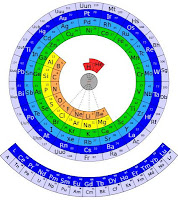Periodic Classification of Elements
 |
| Circular Periodic Table credits:wpclipart |
MCQs
Q1(NCERT): Which of the following statements is not a correct statement about the trends when going from left to right across the periods of periodic Table.
(a) The elements become less metallic in nature.
(b) The number of valence electrons increases.
(c) The atoms lose their electrons more easily.
(d) The oxides become more acidic.
Q2(NCERT): Element X forms a chloride with the formula XCl2, which is a solid with a high melting point. X would most likely be in the same group of the Periodic Table as
(a) Na
(b) Mg
(c) AI
(d) Si
Q3: Which of the following is a Döbereiner's triad?
(a) Ne, Ca, Na
(b) H2, N2, O2
(c) Li, Na, K
(d) Na, Br, Ar
Q4: Name the scientist who gave the Law of octaves?
(a) Mendeleev
(b) Newlands
(c) Dalton
(d) Döbereiner
Q5: Mendeleev’s periodic table is based on the
(a) Atomic weight
(b) Atomic number
(c) Atomic radius
(d) Atomic volume.
Q6: Which of the following is not an inert gas?
(a) Helium (He)
(b) Argon (Ar)
(c) Bromine (Br)
(d) Radon (Rn)
Q7: When we move from left to right across a period, the electron affinity
(a) remains the same
(b) approaches zero
(c) decreases
(d) increases
Q8: Which element still has dicey position in modern periodic table?
(a) Carbon
(b) Nitrogen
(c) Oxygen
(d) Hydrogen
Q9: Modern periodic table is based on _______.
(a) atomic mass
(b) mass number
(c) atomic number
(d) atomic volume
Q10: The law of triads is not applicable on
(a) Cl, Br, I
(b) S, Se, Te
(c) Na, K, Rb
(d) Ca, Sr, Ba
Q11: Which of the following elements is a semi-metal ?
(a) Aluminium
(b) Chlorine
(c) Sodium
(d) Silicon
Q12: As we move from left to right in a period in modern periodic table, Atomic sizes of the elements generally
(a) increase
(b) decrease
(c) remain same
(d) approach zero
Q13: As we move from top to bottom in a group in modern periodic table, generally atomic size of elements
(a) increases
(b) decreases
(c) remains same
(d) approaches zero
Q14: Which group of elements in modern periodic table is referred 'alkali metals'
(a) Group 1
(b) Group 2
(c) Group 17
(d) Group 18
Q15: Group 17 elements are also called as
(a) Alkali Metals
(b) Alkaline Earth Metals
(c) Halogens
(d) Noble Gases
Q16: Group 18 elements are also called as
(a) Alkali Metals
(b) Alkaline Earth Metals
(c) Halogens
(d) Noble Gases
Answers:
1: (c) The atoms lose their electrons more easily.
2: (b) Mg
3: (c) Li, Na, K
4: (b) Newlands
5: (a) Atomic weight
6: (c) Bromine (Br)
7: (d) increases
8: (d) Hydrogen
9: (c) atomic number
10: (c) Na, K, Rb
11: (d) Silicon
12: (b) decrease
13: (a) increases
14: (a) Group 1
15: (c) Halogens
16: (d) Noble Gases
thank u so much
ReplyDeleteThanks very much helpful
ReplyDeleteThank u very much.....BT can u upload some more questions which may help in competitive sort of exams.....
ReplyDeleteREALLY IT IS VERY HELPFUL TO ME
ReplyDelete